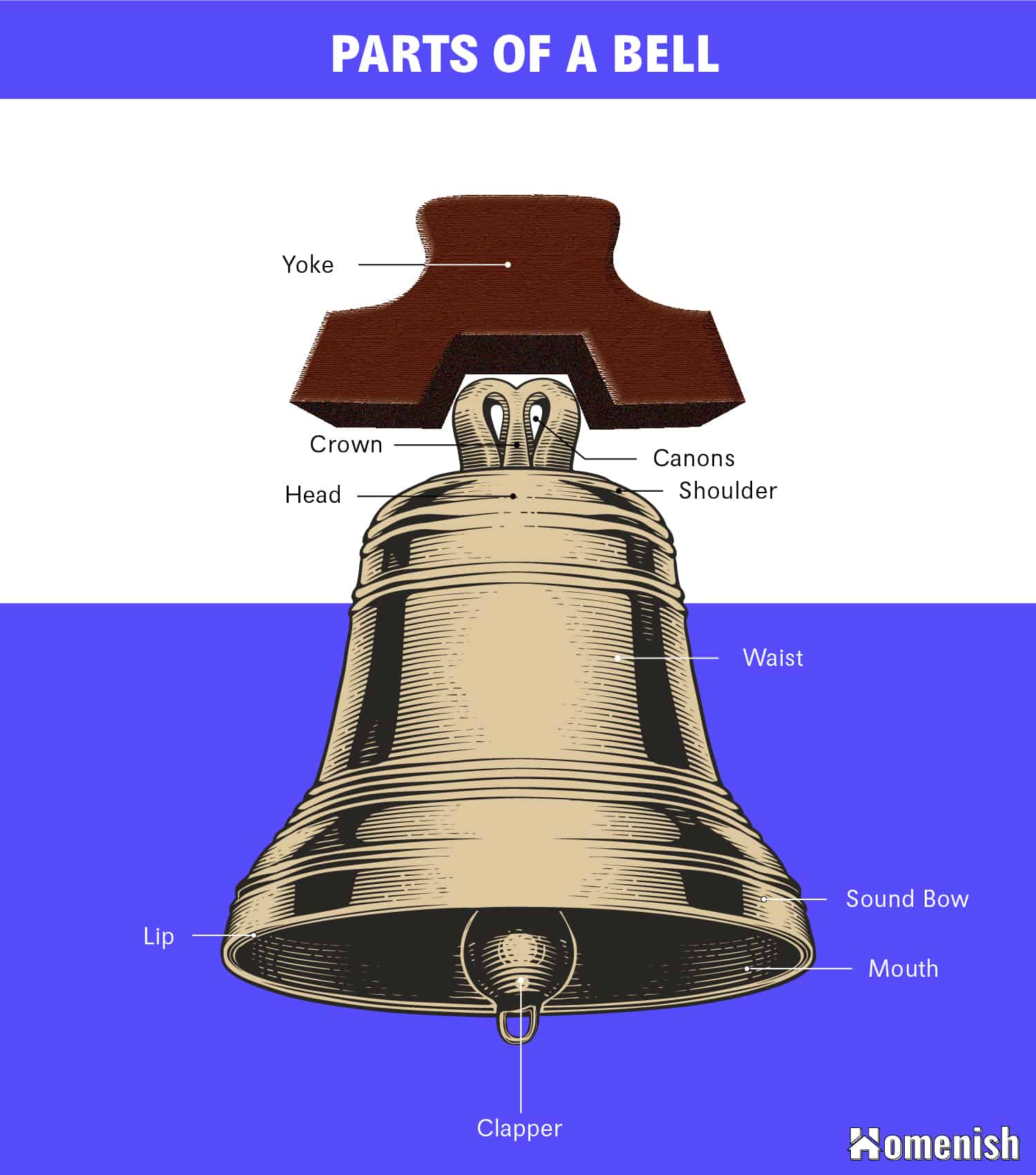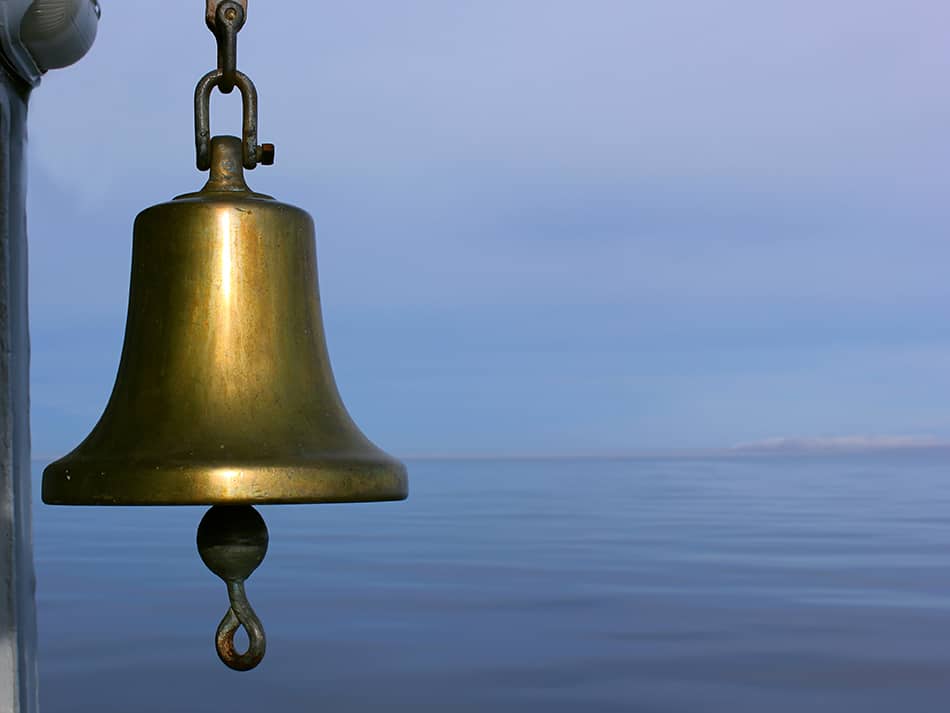A bell is a type of percussion instrument which is struck directly, and this causes the bell to make a single strike note. There are many different types of bells with different uses, some of which have a suspended clapper that hits the side of the bell to make a sound, and some can be hit externally with a hammer. Some types of bells can have small metal balls enclosed within the outer bell casing, which strike the sides of the bell when shaken to make a chiming sound.
In the western world, the most prominent types of bells are church bells or tower bells. These are typically large cup-shaped bells that are hung or mounted within a tower, and they can be struck using various methods. Tower bells are traditionally cast from a type of bronze known as ‘bell metal’. Other bells might also be made from glass, ceramics, or different types of metal.
Tower bells or church bells can be heard on various occasions, and these differ from location to location. Many churches will sound their bells in celebration, such as during a wedding ceremony, while others may create dull-sounding chimes at funerals or times of mourning. Some bells chime hourly to mark the passing of time, while others ring out at a set time every day.
We put together an illustrated diagram about the anatomy of a bell below.

Detailed Parts of a Bell
Yoke
The bell yoke, also known as the headstock, is generally a chunky piece of wood or metal on which the bell is strapped or fixed onto. In bell towers, the yoke of the bell moves from side to side to create a swinging action, and it is this which makes the bell ring. Traditionally a bell yoke would be made from solid oak. Wooden yokes can shrink over time due to the natural drying-out process, and this can result in the loosening of the bell. Wooden yokes should be annually maintained to ensure the bell is fixed tightly in place.
Canons
Bell canons are metal loops on the top of the bell, which are used to attach the bell to the yoke. The strongest and most long-lasting bells will have canons that are cast as part of the bell, with one solid piece of metal. Canons which have been riveted or welded onto the bell after the fact are more likely to come loose or break down.
Head
The head of a bell is the central part of the very top surface of the bell. The canons are fitted to the head of the bell.
Crown
The crown of a bell surrounds the head of the bell and is the part that wraps itself around the upper top edge of the bell.
Shoulder
The shoulder of the bell sits below the crown and above the waist.
Waist
The waist of a bell is the middle section of the bell. Typically this part of the bell will have a gently flared shape that gets wider towards the bottom.
Sound Bow
This part of the bell is called the sound bow because it is the area where the clapper strikes and causes the bell to sound. It is the thicker part of the bell and is located at the base. The quality of the sound bow can have a big impact on the sound the bell makes.
Lip
The lip of a bell is the lower outermost edge of the bell. This part of the bell can also be struck, and it will achieve a different sound to when the sound bow is struck.
Mouth
The mouth of the bell is located along the inner bottom edge of the bell. This is easy to remember because it is inside the lips of the bell.
Clapper
The bell clapper is the suspended striker inside a bell that hangs down from the upper central part of the bell. A clapper is usually made from metal and can swing around freely inside the bell. The movement of the clapper within the bell causes it to hit the sides of the bell, and it is this which makes the chiming sound.
This can be achieved by manually ringing the bell to cause the movement of the clapper, or for swinging bells the yoke will swing back and forth, and the momentum will cause the clapper to knock against the sides of the bell. Good clappers will be fitted in a way that ensures they reliably hit the soundbar each and every time.
Some clappers which become worn or misshapen with age can cause damage to the body of the bell, and therefore need to be routinely inspected and in some circumstances, replaced. If a bell suffers from cracks that appear towards the mouth of the bell this can indicate that the clapper is made from a material that is too hard or heavy.
Famous Bells:
- Sigismund: This bell is situated in Wawel Cathedral in Kraków, Poland, and weighs 12 tonnes. It was cast in 1520, and can only be heard ringing during events of great national significance.
- Big Ben: This is the bell for the Great Clock located in the Elizabeth Tower at the Houses of Parliament in London. It chimes on the hour, every hour.
- Tsar Bell: This remains the largest existing bell, at 160 tons. It has never been rung and is kept on display inside the Kremlin in Moscow, Russia.
- Liberty Bell: This is an iconic bell symbolizing American independence. It is located in Philadelphia, Pennsylvania, in the Liberty Bell Center.
- Great Mingun Bell: This bell has held the title of the largest functioning bell in the world on several occasions, but currently takes second place. It weighs 90 tons and is located in the Sagaing Region of Myanmar. It does not have a clapper and is rung be being struck on the outer lip.
- Bell of Good Luck: This is the reigning largest functioning bell in the world, at 105 tons. It was cast in December of the year 2000 and resides in the Foquan Temple, China.






